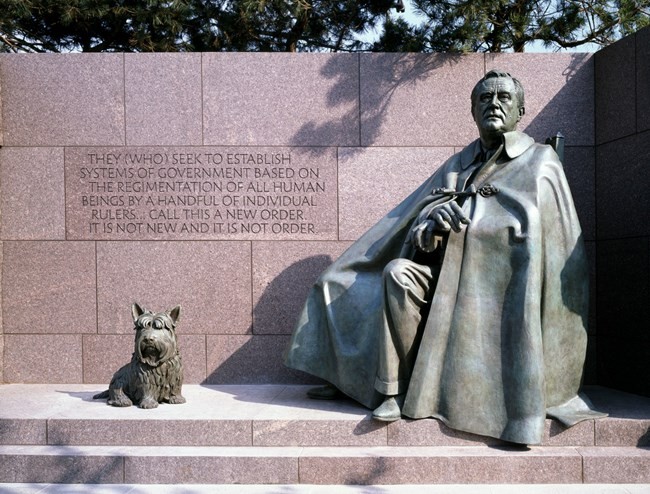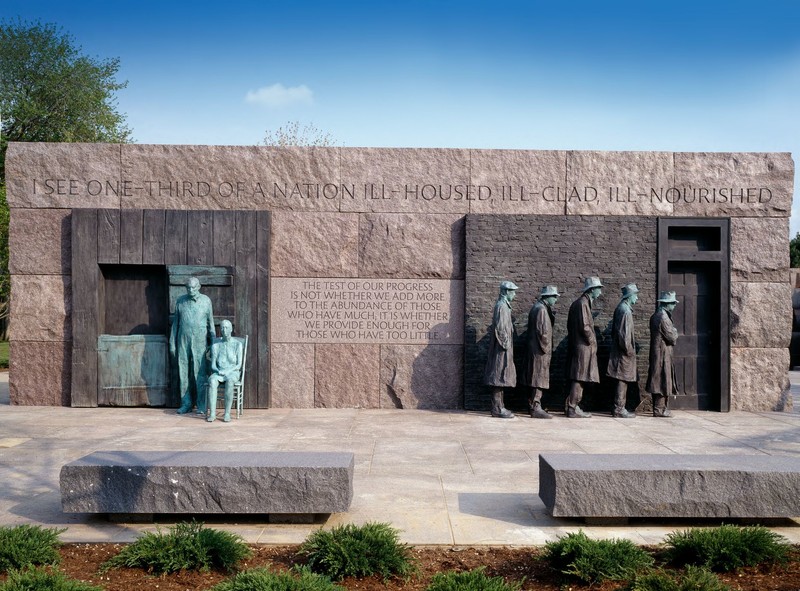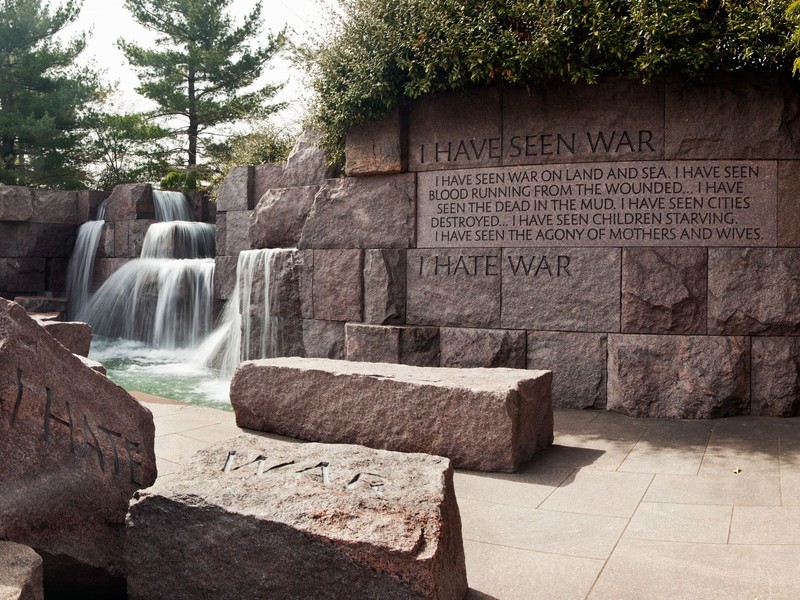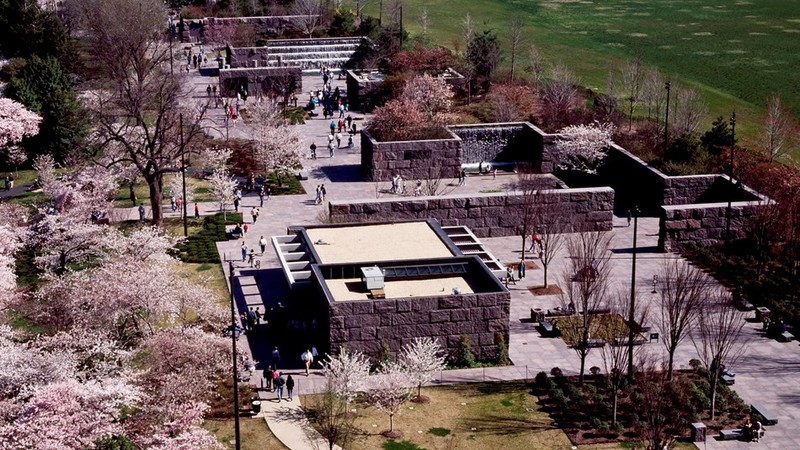Franklin Delano Roosevelt Memorial
Introduction
Text-to-speech Audio
Images
Bronze sculptures of President Roosevelt and his faithful canine companion, Fala

Two additional bronze sculptures found in the memorial

One of the memorial's many Roosevelt quotations etched into its granite walls

The bronze sculpture of Roosevelt in his wheelchair

An aerial view of the memorial

A photograph of Roosevelt taken in 1933

Backstory and Context
Text-to-speech Audio
Franklin Delano Roosevelt was born into a wealthy and well-connected family on January 30, 1882 in Hyde Park, New York. The only child of James and Sara Delano Roosevelt, he was educated at home by private tutors and at the elite Groton School in Massachusetts before enrolling at Harvard College. Following his graduation from Harvard in 1903, Roosevelt attended law school at Columbia University. During this time, he married a distant cousin and niece of President Theodore Roosevelt, Anna Eleanor Roosevelt. The marriage produced six children, five of whom survived to adulthood. After passing the bar, Roosevelt left law school before earning his degree and took a job with a prominent New York City law firm.
In 1910, Roosevelt entered politics when he successfully ran for a seat in the New York State Senate as a Democrat. Three years later, President Woodrow Wilson appointed him assistant secretary of the Navy, a position he would occupy for seven years. In 1920, the Democratic Party chose Roosevelt to be its vice-presidential nominee. That November, he and his running mate, Ohio Governor James Cox, were soundly defeated by Republicans Warren G. Harding and Calvin Coolidge. Less than a year later, in the summer of 1921, a paralytic illness (most likely Guillain-Barré syndrome, not polio as it was believed to be at the time) robbed Roosevelt of the use of his legs in the prime of his life. Determined to overcome the devastating development, he endured years of physical therapy and learned to walk short distances with heavy leg braces and the help of an aid. Roosevelt resumed his political career in 1928, when he successfully ran to become governor of New York. Two years later, the people of New York reelected him by a wide margin. In 1932, as the country slipped deeper into the Great Depression, Roosevelt captured his party’s nomination for President of the United States and trounced incumbent Republican Herbert Hoover in the general election.
Roosevelt ultimately won reelection to the presidency three consecutive times (1936, 1940, and 1944), serving for a total of just over twelve years. During his time in office, he enacted the New Deal, the collective term used to describe a series of government programs and reform measures aimed at combating the effects of the Great Depression and preventing something like it from happening again. Some of the lasting features of the New Deal include Social Security and the FDIC. Later in his tenure, Roosevelt shepherded the nation through the Second World War, the deadliest conflict in human history. Although he was popular among most Americans at the time, his failed attempt to pack the Supreme Court and purge his party of conservatives, in addition to a self-inflicted recession in 1937, tarnished his reputation. On April 12, 1945, while vacationing in Warm Springs, Georgia, Roosevelt died of a cerebral hemorrhage. He was sixty-three years old.
Following Roosevelt’s death, Congress established the Franklin Delano Roosevelt Memorial Commission in 1955. After nearly two decades of delay, the commission chose landscape architect Lawrence Halprin to design the memorial in 1974. Dedicated on May 2, 1997 by President Bill Clinton, it consists of five loosely-defined outdoor areas, four of which focus on Roosevelt’s four terms in office. Constructed of over four and a half tons of South Dakota red granite and utilizing 100,000 gallons of water, the memorial features several bronze sculptures and reliefs designed by various artists, in addition to a large waterfall, reflecting pool, and numerous quotations etched into the granite walls. After the National Organization on Disability criticized the memorial for not adequately addressing Roosevelt’s disability, a bronze sculpture of the president in his wheelchair was added in 2001.
Sources
"Franklin Delano Roosevelt Memorial." NPS.gov. U.S. Department of the Interior. Web. 9 April 2021 <https://www.nps.gov/places/franklin-delano-roosevelt-memorial.htm>.
Freidel, Frank and Hugh S. Sidey. The Presidents of the United States of America. Washington, DC: White House Historical Association, 2006.
History.com Editors. "Franklin D. Roosevelt." History. A&E Television Networks. 1 April 2021. Web. 9 April 2021 <https://www.history.com/topics/us-presidents/franklin-d-roosevelt>.
"The Franklin Delano Roosevelt Memorial." NPS.gov. U.S. Department of the Interior. Web. 9 April 2021 <https://www.nps.gov/frde/learn/historyculture/aboutfrde.htm>.
https://www.nps.gov/frde/learn/historyculture/aboutfrde.htm
https://www.loc.gov/item/2011630605/
https://www.thoughtco.com/fdr-memorial-in-washington-d-c-1779901
https://www.nationalparks.org/connect/explore-parks/franklin-delano-roosevelt-memorial
https://www.nps.gov/frde/index.htm
https://en.wikipedia.org/wiki/File:FDR_in_1933.jpg
